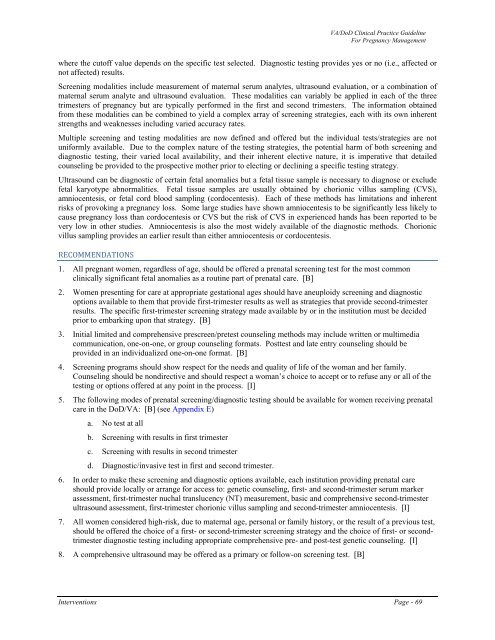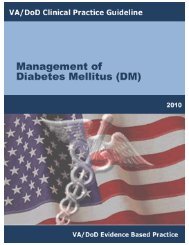Management of pregnancy - VA/DoD Clinical Practice Guidelines ...
Management of pregnancy - VA/DoD Clinical Practice Guidelines ...
Management of pregnancy - VA/DoD Clinical Practice Guidelines ...
Create successful ePaper yourself
Turn your PDF publications into a flip-book with our unique Google optimized e-Paper software.
<strong>VA</strong>/<strong>DoD</strong> <strong>Clinical</strong> <strong>Practice</strong> Guideline<br />
For Pregnancy <strong>Management</strong><br />
where the cut<strong>of</strong>f value depends on the specific test selected. Diagnostic testing provides yes or no (i.e., affected or<br />
not affected) results.<br />
Screening modalities include measurement <strong>of</strong> maternal serum analytes, ultrasound evaluation, or a combination <strong>of</strong><br />
maternal serum analyte and ultrasound evaluation. These modalities can variably be applied in each <strong>of</strong> the three<br />
trimesters <strong>of</strong> <strong>pregnancy</strong> but are typically performed in the first and second trimesters. The information obtained<br />
from these modalities can be combined to yield a complex array <strong>of</strong> screening strategies, each with its own inherent<br />
strengths and weaknesses including varied accuracy rates.<br />
Multiple screening and testing modalities are now defined and <strong>of</strong>fered but the individual tests/strategies are not<br />
uniformly available. Due to the complex nature <strong>of</strong> the testing strategies, the potential harm <strong>of</strong> both screening and<br />
diagnostic testing, their varied local availability, and their inherent elective nature, it is imperative that detailed<br />
counseling be provided to the prospective mother prior to electing or declining a specific testing strategy.<br />
Ultrasound can be diagnostic <strong>of</strong> certain fetal anomalies but a fetal tissue sample is necessary to diagnose or exclude<br />
fetal karyotype abnormalities. Fetal tissue samples are usually obtained by chorionic villus sampling (CVS),<br />
amniocentesis, or fetal cord blood sampling (cordocentesis). Each <strong>of</strong> these methods has limitations and inherent<br />
risks <strong>of</strong> provoking a <strong>pregnancy</strong> loss. Some large studies have shown amniocentesis to be significantly less likely to<br />
cause <strong>pregnancy</strong> loss than cordocentesis or CVS but the risk <strong>of</strong> CVS in experienced hands has been reported to be<br />
very low in other studies. Amniocentesis is also the most widely available <strong>of</strong> the diagnostic methods. Chorionic<br />
villus sampling provides an earlier result than either amniocentesis or cordocentesis.<br />
RECOMMENDATIONS<br />
1. All pregnant women, regardless <strong>of</strong> age, should be <strong>of</strong>fered a prenatal screening test for the most common<br />
clinically significant fetal anomalies as a routine part <strong>of</strong> prenatal care. [B]<br />
2. Women presenting for care at appropriate gestational ages should have aneuploidy screening and diagnostic<br />
options available to them that provide first-trimester results as well as strategies that provide second-trimester<br />
results. The specific first-trimester screening strategy made available by or in the institution must be decided<br />
prior to embarking upon that strategy. [B]<br />
3. Initial limited and comprehensive prescreen/pretest counseling methods may include written or multimedia<br />
communication, one-on-one, or group counseling formats. Posttest and late entry counseling should be<br />
provided in an individualized one-on-one format. [B]<br />
4. Screening programs should show respect for the needs and quality <strong>of</strong> life <strong>of</strong> the woman and her family.<br />
Counseling should be nondirective and should respect a woman’s choice to accept or to refuse any or all <strong>of</strong> the<br />
testing or options <strong>of</strong>fered at any point in the process. [I]<br />
5. The following modes <strong>of</strong> prenatal screening/diagnostic testing should be available for women receiving prenatal<br />
care in the <strong>DoD</strong>/<strong>VA</strong>: [B] (see Appendix E)<br />
a. No test at all<br />
b. Screening with results in first trimester<br />
c. Screening with results in second trimester<br />
d. Diagnostic/invasive test in first and second trimester.<br />
6. In order to make these screening and diagnostic options available, each institution providing prenatal care<br />
should provide locally or arrange for access to: genetic counseling, first- and second-trimester serum marker<br />
assessment, first-trimester nuchal translucency (NT) measurement, basic and comprehensive second-trimester<br />
ultrasound assessment, first-trimester chorionic villus sampling and second-trimester amniocentesis. [I]<br />
7. All women considered high-risk, due to maternal age, personal or family history, or the result <strong>of</strong> a previous test,<br />
should be <strong>of</strong>fered the choice <strong>of</strong> a first- or second-trimester screening strategy and the choice <strong>of</strong> first- or secondtrimester<br />
diagnostic testing including appropriate comprehensive pre- and post-test genetic counseling. [I]<br />
8. A comprehensive ultrasound may be <strong>of</strong>fered as a primary or follow-on screening test. [B]<br />
Interventions Page - 69
















